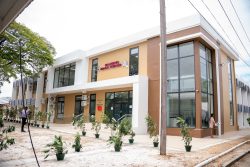As usual, during the rainy season many of our streets become difficult to traverse. Not just because, like several in Festival City and North Ruimveldt, they remain filled with stagnant, muddy water for weeks on end, but also because of the potholes and craters that emerge during this season.
At the moment, some streets in Georgetown, like sections of North Road, are navigable only at a crawl. Vehicles virtually have to be travelling at under five miles an hour to negotiate the holes, some of which cover the road from end to end so that there is no escaping them. North Road is a major thoroughfare, and secondary roads all over the city are likewise affected.
And it is not just in Georgetown. Residents from all around the country have been complaining about the state of their roads. The most recent complaint concerned Agriculture Road in Mon Repos and was published in yesterday’s edition of this newspaper.
Given that Agriculture Road is the only one used to access the Guyana School of Agriculture, the National Agriculture Research and Extension Institute and the Guyana Livestock Development Association, it is a major road in Mon Repos. Yet, for decades it has been subjected to quick fixes which do not last. A resident of the area who wrote a letter to this newspaper complained: “Anyone living around here in the years gone by will tell you that this road is mostly repaired only when a minister of the government is visiting one of the institutions in the area…Then the road is patched up and the sidewalks are trimmed, and I have even seen persons sweeping the road in preparation for the official’s big entrance.”
To the untrained eye, it appears that Agriculture Road has the thinnest layer of bitumen imaginable. Road engineers in the Ministry of Public Infrastructure would be able to determine if this is indeed the case. And if it is it would account for the road constantly being in a state of disrepair. Not only is it a well-traversed road, but given the industries accessible from it and its location, heavy vehicles, like trucks, obviously use it. Agriculture Road, therefore, ought to have been a sturdy, well-built thoroughfare. It is not.
It does not take a genius to figure out that major roads like the East Coast and East Bank public roads are built to different specifications, not only in terms of width and length, but also in terms of the quality of materials used. Secondary streets that form part of local infrastructure, for which residents pay rates to town councils and neighbourhood democratic councils, often seem not to be built to last.
It is possible that whichever agency or individual is responsible for the specifications on secondary roads assumes that they will not be as heavily traversed as the main roads. And while this is true, one also needs to take into account that the drivers on the main roads use secondary roads to deliver items to persons’ homes and to get to their own homes as well. Vehicles weighed down with construction material must use secondary roads; homes and industries have to be built. Sanitation vehicles and movers’ trucks also make a case for solid secondary roads.
It is penny wise and pound foolish to try and spend less on secondary roads and then have to expend those savings on constant repairs in short time spans. In fact, it costs more in the long run given that there often has to be a tender process, which involves a lot of time spent doing costing and estimates. Then there is the almost surety of road building materials getting costlier every year, not to mention the labour and machines involved in such projects.
The seeming lack of good sense which prevails when it comes to drainage also adds to those costs. As stated earlier, it is obvious that lodged water undermines and damages the roads, and yet in the city and in towns and rural areas, there is what appears to be a reluctance to seriously tackle drainage. Again, it seems to indicate a preference for cost savings, with no thought given to the long-term effect – at least outside of the city. In Georgetown, there is a lack of political will, especially at the level of the City Council, to reclaim canal embankments from squatters. This has been the case for decades and it seems unlikely to change in the near future.








